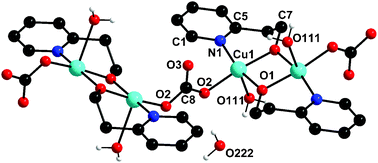The oxyanions (NO3−, CO32−) and phenoxyacetate (PhOAc−) bridged three 1D-coordination polymeric chains, {[Cu2(μ-hep)2(μ-NO3)]2}n (1), {[Cu2(μ-hep)2(H2O)2]·2H2O(μ-CO3)}n (3) and {[Cu2(μ-hep)2(μ-PhOAc−)]2}n (2) (hep-H = 2-(2-hydroxyethyl)pyridine) have been synthesized. In 1–3 the alkoxide bridged dicopper building units, [Cu(μ-hep)]2 with Cu2O2 core, are linked via the respective anions. Detailed structural analysis reveals that in 1 or 2, two units of NO3− (1) or PhOAc− (2), respectively, bind with the four copper ions in two adjacent alkoxide bridged dimeric units in head-to-head and tail-to-tail fashion and the same binding mode continues along the polymeric chain. This in effect yields a 12-membered metallacyclic ring in between two dimeric core units. However, in 3 only one CO32−group bridges the two copper centres associated with the two neighbouring alkoxide bridged dimeric units in head-to-tail mode which in turn forms a zig-zag polymeric chain. Two coordinated and two lattice water molecules from two adjacent polymeric layers in the structure of 3 form water tetramers. Furthermore, the interaction of water tetramer with the uncoordinated –C![[double bond, length as m-dash]](https://www.rsc.org/images/entities/char_e001.gif) O group of the bridging CO32− develops an additional zig-zag chain which is being trapped between the two outer zig-zag coordination polymeric chains in 3. The polymeric chains in 1–3 further develop a 2D-network pattern via an extensive non-covalent hydrogen bonding as well as C–H⋯π and π⋯π interactions.
O group of the bridging CO32− develops an additional zig-zag chain which is being trapped between the two outer zig-zag coordination polymeric chains in 3. The polymeric chains in 1–3 further develop a 2D-network pattern via an extensive non-covalent hydrogen bonding as well as C–H⋯π and π⋯π interactions.

You have access to this article
 Please wait while we load your content...
Something went wrong. Try again?
Please wait while we load your content...
Something went wrong. Try again?
![[double bond, length as m-dash]](https://www.rsc.org/images/entities/char_e001.gif) O group of the bridging CO32− develops an additional zig-zag chain which is being trapped between the two outer zig-zag coordination polymeric chains in 3. The polymeric chains in 1–3 further develop a 2D-network pattern via an extensive non-covalent hydrogen bonding as well as C–H⋯π and π⋯π interactions.
O group of the bridging CO32− develops an additional zig-zag chain which is being trapped between the two outer zig-zag coordination polymeric chains in 3. The polymeric chains in 1–3 further develop a 2D-network pattern via an extensive non-covalent hydrogen bonding as well as C–H⋯π and π⋯π interactions.

 Please wait while we load your content...
Please wait while we load your content...